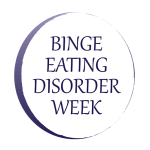Binge Eating Disorder out of the closet
Binge Eating Disorder out of the closet
I suffered anorexia as a child, and transitioned to bulimia before the illness was given a name (by British psychiatrist Gerald Russell in 1979).
But if I had developed Binge Eating Disorder (this month listed as a recognized illness in the Diagnostic and Statistical Manual of Mental Disorders – called the DSM-5) the recovery challenge would have been greater, the stigma and the bullying more intense and real.
- Chevese Turner, founder of the Binge Eating Disorder Association.
Which is why I greatly admire Chevese Turner, founder of the Binge Eating Disorder Association.
Chevese, in A Clinician’s Guide to Binge Eating Disorder, describes what it is like, as a child, finding temporary comfort and solace in hoarding and consuming enormous amounts of food and progressively feeling hopelessly out of control. Growing up, knowing something was not right, but not knowing what or why, was awfully confusing.
Chevese is amazing: she knew something was not ‘normal’ about how she was living her life, and did not give up searching for answers. Today she is devoted to raising awareness of Binge Eating Disorder, and to doing all she can to encourage our society to quit talk about diets and weights. They don’t work!
We are more than our weight
Chevese explains why:
Stories abound about people with BED and other eating disorders who have been bullied and discriminated against (and I have experienced it myself) around body size. This is why BEDA took on eliminating weight stigma as a part of our mission and created an awareness week.
It is amazing that as a society we continue to embrace this type of very hateful “speech” by not speaking out against it. It is also amazing that it is still fine to make fun of people of size on TV, in movies, in books, etc. It is still fine to discriminate blatantly against anyone who is not the “norm”. It is still fine to put them in unflattering positions and photograph them as a way to humiliate. It is still fine to use pictures of people of size with no heads.
If you are not convinced how pervasive it is, spend an evening watching television and count how many times you hear a fat joke or a passing quip about how awful it is to be fat. There is not a show that goes by that does not include something.
Would anyone in their right mind in this day-and-age be as cruel to someone with a physical handicap? Would it be acceptable to so blatantly talk about one’s dislike of the LGBTQ (Lesbian, Gay, Bisexual, Trans and Queer) community or use a derogatory term around race in a public way? Absolutely not. It would be called out and all over the news. Letters would be written en masse by many groups.
The amount of research being done around weight stigma is astounding these days (relative to the past). Rebecca Puhl, at the RUDD Center, is one example of a person dedicated to this research and many others are emerging. In fact, there is an entire conference in the UK this month with speakers from all over the world focused only on weight stigma. We know that people who are stigmatized around weight are more likely to engage in eating disorder behaviors — including bingeing. The research is here — we have the evidence — it’s time to no longer turn a blind eye to this reality and what it is doing to people. Our community needs to be at the forefront of helping the remainder of our “civil society” realize that it is not something that will be tolerated.
I call on everyone treating people with eating disorders to consider learning the research we have and how it might impact the clients you see. I also beg you, if you are a researcher, to engage in further studies around this. There is much to learn and many are theorizing that internalized weight stigma is a trauma that contributes to the manifestation and maintenance of eating disorders for some.
It’s time for our community, including the professional and academic community, to speak out.
A Clinician’s Guide to Binge Eating Disorder
Treating Binge Eating Disorder, and overcoming it, is all the more difficult when living in a culture that has an intense body image focus.
A Clinician’s Guide to Binge Eating Disorder educates the reader about its triggers and behaviours – and describes steps to treat it and resume a full and productive life. Evidence-based research outcomes provide the framework and foundation for this book.
First-person case studies bring application of this science to life to help close the gap between research and treatment/care, and the importance of clinicians developing a therapeutic relationship as a healing tool with their client is discussed, recognizing that medical and psychological dimensions are inextricably intertwined.
This book allays fear of the unknown, explains the emotional chaos that can sweep in like a storm when, unintentionally, triggers are released.
It provides practical steps and footholds for clinicians and researchers to help the patient take control of their life and look to a positive future.
Contents
Devlin, Wonderlich, Walsh, Mitchell, Foreword.
Part I: The Search For Causes. White, Gianini, Bed and Obesity. Franko, Lovering, Thompson Brenner, Ethnicity. Bulik, Trace, Genetics.Goldschmidt, Boutelle (With Knatz, Madowitz), Tanofsky-Kraff, Children and Adolescents: Loss of Control Eating Risk Factors, Correlates, Outcome and Assessment. Karr, Simonich, Wonderlich, Binge Eating Disorder, Childhood Trauma, and Psychiatric Comorbidity. Mond, Hay, Comorbidity and Related Considerations. Hilbert, Hartmann, Body Image (Disturbance).Arnold, Empower the Patient With Science.
Part II: The Search For Solutions. Banker, Introduction: Closing the Research-Clinical Gap. Berg, Peterson, Assessment. Segal, Altman, Weissman, Safer; Chen, Dialectical Behavior Therapy for Binge-Eating Disorder. Wilfley, Mcclendon-Iacovino, Gredysa, Psychological Interventions (Cbt, Ipt). Crow, Psychopharmacologic Interventions. Osborn, Miller, Vannucci, Goldschmidt, Boutelle (With Knatz and Madowitz), Tanofsky-Kraff, Children and Adolescents: Loss of Control Eating Interventions. Engel, Mitchell, Bariatric Surgery. Accurso, Sánchez-Johnsen, Behavioural Weight Loss. Pershing, The Clinician’s Toolbox. Field, Sonneville, Prevention. Turner (Beda), Assisting the Translation from Research to Practice – Two Perspectives: Part One. Grefe (Neda), Assisting the Translation from Research to Practice – Two Perspectives: Part Two.
Devlin, Wonderlich, Walsh, Mitchell, Afterword.
What is Binge Eating Disorder?
Binge eating disorder (BED) is the most common eating disorder in the United States. An estimated 3.5% of women, 2% of men, and 30% to 40% of those seeking weight loss treatments can be clinically diagnosed with binge eating disorder. The disorder impacts people of all ages—including children and adolescents, races, and levels of education and income.
Binge eating disorder is characterized by recurring episodes of binge eating, feeling out of control while binging, and feeling guilt and shame afterward.
What Is A Binge?
A “binge” can vary widely in amount of food consumed. While it might mean a considerable amount for some, it can mean a smaller amount for others. Regardless of the amount of food eaten, the person still feels out of control to stop, with distress following the episode.
Although those with binge eating disorder are more likely than average to be of higher weight, anyone at any weight may struggle with the disorder. For those at higher weights, the presence of cultural weight stigma and bullying experiences may contribute to a greater degree to the development of binge eating disorder, as well as co-occurring mood disorders and addictions.








